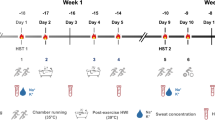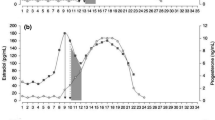Abstract
In this paper, we present an application of a number of tools and concepts for modeling and analyzing raw, unaveraged, and unedited breath-by-breath oxygen uptake data. A method for calculating anaerobic capacity is used together with a model, in the form of a set of coupled nonlinear ordinary differential equations to make predictions of the \(\dot{V}O_{2}\) kinetics, the time to achieve a percentage of a certain constant oxygen demand, and the time limit to exhaustion at intensities other than those in which we have data. Speeded oxygen kinetics and increased time limit to exhaustion are also investigated using the eigenvalues of the fixed points of our model. We also use a way of analyzing the oxygen uptake kinetics using a plot of \(\ddot{V}O_{2}(t)\) vs \(\dot{V}O_{2}(t)\) which allows one to observe both the fixed point solutions and also the presence of speeded oxygen kinetics following training. A method of plotting the eigenvalue versus oxygen demand is also used which allows one to observe where the maximum amplitude of the so-called slow component will be and also how training has changed the oxygen uptake kinetics by changing the strength of the attracting fixed point for a particular demand.
Similar content being viewed by others
References
Astrand, P.O., Saltin, B., 1961. Oxygen uptake during the first minutes of heavy muscular exercise. J. Appl. Physiol. 16(6), 971–76.
Bangsbo, J., 1992. Is the O2 deficit an accurate quantitative measure of the anaerobic energy production during intense exercise? J. Appl. Physiol. 73(3), 1207–209.
Bangsbo, J., 1996a. Oxygen deficit: a measure of the anaerobic energy production during intense exercise? Can. J. Appl. Physiol. 21(5), 350–63.
Bangsbo, J., 1996b. Physiological factors associated with efficiency in high intensity exercise. Sports Med. 22(5), 299–05.
Bangsbo, J., 1998. Quantification of anaerobic energy production during intense exercise. Med. Sci. Sports Exerc. 30(1), 47–2.
Barstow, T.J., Mole, P.A., 1991. Linear and nonlinear characteristics of oxygen uptake kinetics during heavy exercise. J. Appl. Physiol. 71(6), 2099–106.
Bell, C., Paterson, D.H., Kowalchuk, J.M., Moy, A.P., Thorp, D.B., Noble, E.G., Taylor, A.W., Cunningham, D.A., 2001. Determinants of oxygen uptake kinetics in older humans following single-limb endurance exercise training. Exp. Physiol. 86, 659–65.
Billat, V.L., 2001a. Interval training for performance: a scientific and empirical practice. Part I: Aerobic interval training. Sports Med. 31(1), 13–1.
Billat, V.L., 2001b. Interval training for performance: a scientific and empirical practice. Part II: Anaerobic interval training. Sports Med. 31(2), 75–0.
Billat, V.L., Koralsztein, J.P., 1996. Significance of the velocity at \(\dot{V}O_{2_{\max}}\) and time to exhaustion at this velocity. Sports Med. 22(2), 90–08.
Billat, V.L., Morton, R.H., Blondel, N., Berthoin, S., Bocquet, V., Koralsztein, J.P., Barstow, T.P., 2000. Oxygen kinetics and modelling of time to exhaustion whilst running at various velocities at maximal oxygen uptake. Eur. J. Appl. Physiol. 82, 178–87.
Billat, V.L., Mille-Hamard, L., Demarle, A., Koralsztein, J.P., 2002. Effect of training in humans on off- and on-transient oxygen uptake kinetics after sever exhausting intensity runs. Eur. J. Appl. Physiol. 87, 496–05.
Billat, V.L., Wesfreid, E., Cottin, F., Kapfer, C., Koralsztein, J.-P., Bonneau, S., Meyer, Y., 2003. Fractal analysis of speed and physiological oscillations in long- and middle-distance running: effect of training. Int. J. Comp. Sci. Sport. 2(2), 16–0.
Borrani, F., Canadau, R., Millet, G.Y., Perrey, S., Fuchslocher, J., Rouillon, J.D., 2001. Is the \(\dot{V}O_{2}\) slow component dependant upon progressive recruitment of fast-twitch fibres in trained runners. J. Appl. Physiol. 90, 2212–220.
Brandenburg, S.L., Reusch, J.E.B., Bauer, T.A., Jeffers, B.W., Hiatt, W.R., Regenteiner, J.G., 1999. Effects of exercise training on oxygen uptake kinetics responses in women with type II diabetes. Diabetes Care. 22, 1640–646.
Carter, H., Jones, A.M., Barstow, T.J., Burnley, M., Williams, C.A., Doust, J.H., 2000. Effect of endurance training on oxygen uptake kinetics during treadmill running. J. Appl. Physiol. 89, 1744–752.
Casaburi, R., Storer, T.W., Ben-Dov, I., Wasserman, K., 1987. Effect of endurance training on possible determinants of \(\dot{V}O_{2}\) during heavy exercise. J. Appl. Physiol. 62, 199–07.
Cerretelli, P., Pendergast, D., Paganelli, W.C., Rennie, D.W., 1979. Effects of specific muscle training on \(\dot{V}O_{2}\) on-response and early blood lactate. J. Appl. Physiol. 47, 761–69.
Davies, C.T., Di Prampero, P.E., Cerretelli, P., 1972. Kinetics of the cardiac output and respiratory gas exchange during exercise and recovery. J. Appl. Physiol. 32, 618–25.
Daniels, J.T., 2005. Daniels Running Formular, Proven Programs 800 m to the Marathon, 2nd edn. Human Kinetics, Champaign.
Demarle, A.P., Slawinski, J.J., Lafitte, L.P., Bocquet, V.G., Koralsztein, J.P., Bilat, V.L., 2001. Decrease of O 2 deficit is a potential factor in increased time to exhaustion after specific endurance training. J. Appl. Physiol. 90, 947–53.
Faina, M., Billat, V., Squadrone, R., De Angelis, M., Koralsztein, J.P., Dal, A., 1997. Anaerobic contribution to the time to exhaustion at the minimal exercise intensity at which maximal oxygen uptake occurs in elite cyclists, kayakists and swimmers. Eur. J. Appl. Physiol. 76, 13–0.
Gaesser, G.A., Poole, D.C., 1996. The slow component of oxygen uptake in humans. Exerc. Sport Sci. Rev. 24, 35–0.
Goldberger, A.L., Amaral, L.A.N., Hausdorff, J.M., Ivanov, P.C., Peng, C.-K., Stanley, H.E., 2002. Fractal dynamics in physiology: alterations with disease and aging. Proc. Natl. Acad. Sci. USA 99(1), 2466–472.
Gollnick, P.D., Saltin, B., 1982. Significance of skeletal muscle oxidative enzyme enhancement with endurance training. Clin. Physiol. 2, 1–2.
Guckenheimer, J., Holmes, P., 1983. Nonlinear Oscillations, Dynamical Systems and Bifurcations of Vector Fields. Springer, Berlin.
Hagberg, J.M., Hickson, R.C., Ehsani, A.A., Holloszy, J.O., 1980. Faster adjustment to and recovery from submaximal exercise in the trained state. J. Appl. Physiol. 48, 218–24.
Hickson, R.C., Bomze, H.A., Holloszy, J.O., 1978. Faster adjustment of O 2 uptake to energy requirements of exercise in the trained state. J. Appl. Physiol. 44, 877–81.
Hultman, E., Bergstrom, J., Anderson, N.M., 1967. Breakdown and resynthesis of phosphorylcreatin and adenosine triphosphate in connection with muscular working man. Scand. J. Clin. Lab. Invest. 19, 56–6.
Jones, A.M., Carter, H., 2000. The effect of endurance training on parameters of aerobic fitness. Sports Med. 29, 373–86.
Jones, A.M., Koppo, K., 2005. Effect of training on \(\dot{V}O_{2}\) kinetics and performance. In: Jones, A.M., Poole, D.C. (Eds.), Oxygen Uptake Kinetics in Sport, Exercise and Medicine, pp. 373–97. Routledge, London.
Jones, A.M., Poole, D.C., 2005. Oxygen Uptake Kinetics in Sport, Exercise and Medicine. Routledge, London.
Kantz, H., Schreiber, T., 1999. Nonlinear Time Series Analysis. Cambridge University Press, Cambridge.
Karlsson, J., Saltin, B., 1970. Lactate ATP and CrP in working muscles during exhausting exercise in man. J. Appl. Physiol. 29, 598–02.
Karlsson, J., Nordesjo, L.-O., Jorfeldt, L., Saltin, B., 1972. Muscle lactate, ATP and CP levels during exercise after physical training in man. J. Appl. Physiol. 33, 199–03.
Linnarsson, D., 1974. Dynamics of pulmonary gas exchange and heart rate changes at start and end of exercise. Acta Physiol. Scand. Suppl. 415, 1–8.
Martin, D.E., Coe, P.N., 1997. Better Training for Distance Runners. Human Kinetics, Champaign.
Medbo, J.I., Mohn, A.C., Tabata, I., 1988. Anaerobic capacity determined by maximal accumulated O2 deficit. J. Appl. Physiol. 64, 50–0.
Mitra, S.K., 2005. Digital Signal Processing: A Computer—Based Approach, 3rd edn. McGraw–Hill, New York.
Otsuka, T., Kurihara, N., Fujii, T., Fujimoto, S., Yoshikawa, J., 1997. Effect of exercise training and detraining on gas exchange kinetics in patients with chronic obstructive pulmonary disease. Clin. Physiol. 17, 287–97.
Phillips, S.M., Green, H.J., MacDonald, M.J., Hughson, R.L., 1995. Progressive effect of endurance training on \(\dot{V}O_{2}\) kinetics at the onset of submaximal exercise. J. Appl. Physiol. 79, 1914–920.
Press, W.H., Teukolsky, S.A., Vetterling, W.T., Flannery, B.P., 1993. Numerical Recipes in C: The Art of Scientific Computing, 2nd edn. Cambridge University Press, Cambridge.
Proakis, J.G., Manolakis, D.G., 1992. Digital Signal Processing: Principles, Algorithms and Applications, 2nd edn. MacMillan Publishing Company, New York.
Puente-Maestu, L., Tena, T., Trascasa, C., Perez-Parra, J., Godoy, R., Garcia, M.J., Stringer, W.W., 2003. Training improves muscle oxidate capacity and oxygenation recovery kinetics in patients with chronic obstructive pulmonary disease. Eur. J. Appl. Phys. 88, 580–87.
Saltin, B., 1987. The physiological and biochemical basis of aerobic and anaerobic capacities in man; effect of training and range of adaption. In: Maehlum, S. Nilsson, S., Renstrom, P. (Eds.), An Update in Sports Medicine: Proc. 2nd Scand. Conf. in Sports Med., pp. 16–9.
Saltin, B., 1990. Anaerobic capacity: past, present and prospective. In: Taylor, A., Gollmack, P.D. (Eds.), Biochemistry of Exercise VII, pp. 387–12. Human Kinetics, Champaign.
Stirling, J.R., Zakynthinaki, M.S., Saltin, B., 2005. A model of oxygen uptake kinetics in response to exercise: Including a means of calculating oxygen demand/deficit/debt. Bul. Math. Biol. 67(5), 989–015.
Stirling, J.R., Zakynthinaki, M.S., Sillero, M., Sampedro, J., 2007a. Models of oxygen uptake kinetics in response to exercise (submitted).
Stirling, J.R., Zakynthinaki, M.S., Sampedro, J., Refoyo, I., 2007b. A model of heart rate kinetics in response to exercise (submitted).
Wenger, H.A., Bell, G.J., 1986. The interactions of intensity, frequency and duration of exercise training in altering cardiorespiratory fitness. Sport Med. 3, 346–56.
Whipp, B.J., Wasserman, K., 1972. Oxygen uptake kinetics for various intensities of constant load work. J. Appl. Physiol. 33, 351–56.
Whipp, B.J., Rossiter, H.B., Ward, S.A., 2002. Exertional oxygen uptake kinetics: a stamen or stamina? Biochem. Soc. Trans. 30(2), 237–47.
Womack, C.J., Davis, S.E., Blumer, J.L., Barrett, E., Weltman, A.L., Gaesser, G.A., 1995. Slow component of O 2 uptake during heavy exercise. J. Appl. Physiol. 79, 838–45.
Zakynthinaki, M.S., Saridakis, Y.G., 2003. Stochastic optimization for a tip-tilt adaptive correcting system. Comput. Phys. Commun. 150(3), 274–92.
Zakynthinaki, M.S., Stirling, J.R., 2007. Stochastic optimization for modelling physiological time series: application to the heart rate response to exercise. Comput. Phys. Commun. 176, 98–08.
Zakynthinaki, M.S., Stirling, J.R., Sillero, M., Sampedro, J., Refoyo, I., 2007. Obtaining the basic response pattern of physiological time series data: a comparison of methods. Materials Matemátics, Departament de Matemátiques, Universitat Autónoma de Barcelona, 2007 (8).
Author information
Authors and Affiliations
Corresponding author
Rights and permissions
About this article
Cite this article
Stirling, J.R., Zakynthinaki, M.S. & Billat, V. Modeling and Analysis of the Effect of Training on \(\dot{V}O_{2}\) Kinetics and Anaerobic Capacity. Bull. Math. Biol. 70, 1348–1370 (2008). https://doi.org/10.1007/s11538-008-9302-9
Received:
Accepted:
Published:
Issue Date:
DOI: https://doi.org/10.1007/s11538-008-9302-9




